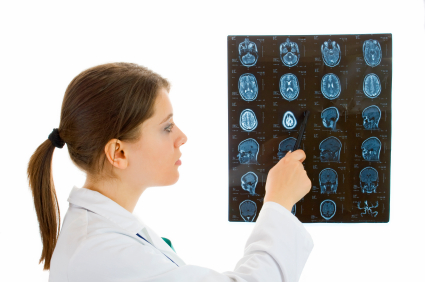UPDATED
Concussions are typically associated with grossly normal structural neuroimaging studies. [1] In other words, unlike other injuries, concussions are usually injuries no one sees and, contrary to popular belief, don't show up on most magnetic resonance imaging (MRI) exams or CT scans.
Because conventionial neuroimaging contributes little to concussion evaluation and management, [1,4] the 4th international consensus statement on sport-related concussion, [1] the 2013 American Academy of Neurology concusson guidelines, [2 the 2013 American Medical Society for Sports Medicine position statement on concussion in sport, [3] the American Academy of Pediatric's 2010 Clinical Report on Sport-Related Concussion in Children and Adolescents, [4] as well as a first-of-its-kind 2015 Canadian study[8] all state that conventional CT or MRI scans of the brain are not needed or recommended in the vast majority of concussions. (the Canadian study found that neuroimaging was normal in 78% of cases of children and adolescents with sports-related concussion)
All acknowledge, however, that CT or MRI are valuable and should be used when there is or has been:
- Whenever there is a suspicion of an intracranial structural injury [1,4,8]
- Loss of consciousness (LOC) for more than a minute [1-3] or 30 seconds [4](remember: a concussions may or may not involve LOC, with 90% of all concussions occurring without LOC);

- Prolonged impairment of the conscious state, especially if there is any suggestion of a deteriorating level of consciousness; [2]
- Dramatic worsening of symptoms, [1,2]
- Severe headache; [4]
- Speech or language difficulties such as aphasia or dysarthria (impaired speech and language skills), poor enunciation, poor understanding of speech, impaired writing,impaired ability to read or to understand writing, inability to name objects (anomia) [4]
- Vision changes such as reduced vision, decreased visual field, sudden vision loss, double vision (diplopia)[1,2,4]
- Neglect or inattention to the surroundings, poor orientation to person, place, or time; [4]
- Loss of coordination, or loss of fine motor control (ability to perform complex movements)
- One-sided eyelid drooping, lack of sweating on one side of the face, and sinking of one eye into the socket;
- Poor gag reflex, swallowing difficulty, and frequent choking;
- Significant drowsiness or difficulty awakening; (4]
- Seizure activity; [4] or
- Worsening post-concussion signs or symptoms, or persistent symptom (longer than 7 to 10 days)(e.g. post-concussion syndrome) [2]
CT or MRI?
A CT scan is the test of choice to evaluate for the four types of intracranial hemorrhage (subdural, epidural, intracerebral, or subarachnoid) bleeding in the brain, swelling of the brain during the first 24 to 48 hours after injury, or to detect a skull fracture [4] because it is faster, more cost-effective, and easier to perform than an MRI. [2,4] No test, however, currently available is sensitive and specific enough to diagnose all intracranial injuries.
An MRI may be more appropriate if imaging is needed 48 hours or longer after an injury [4] to evaluate persistent or worsening symptoms or where there is a concern for underlying pre-existing conditions (eg. headache or seizure disorder, arteriovenous malformation, Chiari malformation, etc.) and is best coordinated through your child's primary care physician or the specialist evaluating your child. [4] Because MRI is viewed as superior in detecting traumatic lesions of the brain, and does not expose patients to radiation, [6] a 2011 study [5] recommends its use for assessing traumatic sport-related brain injuries, especially after the acute period.
Note of caution
The use of CT scans in diagnosing concussion is surprisingly common among neurologists. A 2011 study [5] found the CT rate among neurologists at 72.2%, a rate the study's author and concussion expert, William P. Meehan, III, MD, Director of the Sports Concussion Center at Boston Children's Hospital, said was "probably higher than it needs to be." No wonder, then, that the American Academy of Neurology guidelines state in no uncertain terms that "CT imaging should not be used to diagnose [sport-related concussion]." [2]
In addition to being ineffective (and expensive), there is another reason for fewer CTs: A 2012 study reported in the British medical journal, The Lancet [6] found that children and young adults scanned multiple times by CT have a small increased risk of leukemia and brain tumors in the decade following their first scan. A 2013 study [7] suggests that reducing the highest 25% of radiation doses could prevent 43% of those cancers.
The bottom line: parents should make sure a CT scan is really necessary in treatment of their child after head injury.
1. McCrory P, et al. Concussion statement on concussion in sport: the 4th International Conference on Concussion in Sport held in Zurich, November 2012, Br J Sports Med 2013;47:250-258.
2. Giza C, Kutcher J, Ashwal S, et al. Summary of evidence-based guideline update: Evaluation and management of concussion in sports: Report of the Guideline Development Subcommitee of the Amercian Academy of Neurology. Neurology 2013. DOI:10.1212/WNL.0b013e3182d57dd (published online ahead of print March 18, 2013).
3. Harmon K, et al. American Medical Society for Sports Medicine position statement: concussion in sport. Br J Sports Med 2013;47:15-26.
4. Halstead, M, Walter, K.Clinical Report - Sport-Related Concussion in Children and Adolescents. Pediatrics. 2010;126(3): 597-615.
5. Meehan WP, d'Hemecourt P, Collins C, Comstock RD, Assessment and Management of Sport-Related Concussions in United States High Schools. Am. J. Sports Med. 2011;20(10)(published online on October 3, 2011 ahead of print) as dol:10.1177/0363546511423503 (accessed October 3, 2011).
6. Pearce MS, et al. Radiation exposure from CT scans in childhood and subsequent risk of leukaemia and brain tumours: a retrospective cohort study. The Lancet. June 7, 2012 (published online ahead of print).
7. Miglioretti D, et al. The use of computed tomography in pediatrics and the associated radiation exposure and estimated cancer risk. JAMA Pediatr 2013; DOI: 10.1001/jamapediatrics.2013.311.
8. Ellis MJ, Leiter J, Hall T, McDonald PJ, Sawyer S, Silver N, Bunge M, Essig M. Neuroimaging findings in pediatric sports-related concussion. J Neurosurgery: Pediatrics, published online ahead of print, June 2, 2015; DOI: 10.3171/2015.1.PEDS14510
Revised and updated June 2, 2015








